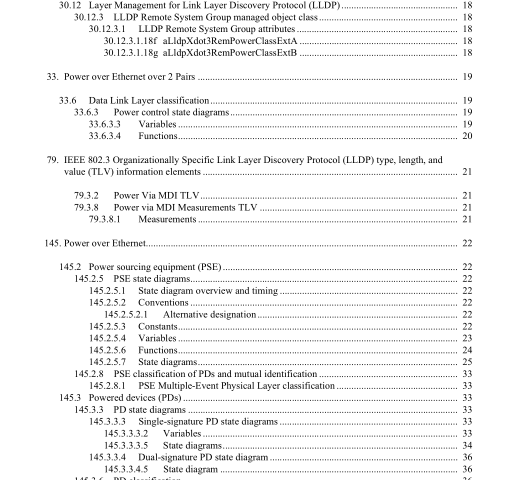IEEE 802.3cv-2021 pdf download.IEEE Standard for Ethernet Amendment 12: Maintenance #15: Power over Ethernet
30.12 Layer Management for Link Layer Discovery Protocol (LLDP)
30.12.3 LLDP Remote System Group managed object class
30.12.3.1 LLDP Remote System Group attributes
Change 30.12.3.1.18f and 30.12.3.1.18g (as inserted by IEEE Std 802.3bt-2018) as follows:
30.12.3.1.18f aLldpXdot3RemPowerClassExtA
ATTRIBUTE
APPROPRIATE SYNTAX:
An ENUMERATED VALUE that has one of the following entries:
singlesig Single-signature PD or 2-pair only PSE
class1 Class 1
class2 Class 2
class3 Class 3
class4 Class 4
class5 Class 5
BEHAVIOUR DEFINED AS:
For a dual-signature PD, a read-only value that indicates the currently assigned Class for Mode A by the remote 4-pair PSE. For a single-signature PD or a dual-signature PD connected to a 2-pair only PSE, a read-only value set to ‘singlesig’ by the remote PSE. For a PSE connected to a dualsignature PD, a read-only value that indicates the requested Class for Mode A during PhysicalLayer classification (see 145.2.8) by the remote PD. For a PSE connected to a single-signature PD,a read-only value set to ‘singlesig’ by the remote PD.;
30.12.3.1.18g aLldpXdot3RemPowerClassExtB
ATTRIBUTE
APPROPRIATE SYNTAX:
An ENUMERATED VALUE that has one of the following entries:
singlesig Single-signature PD or 2-pair only PSE
class1 Class 1
class2 Class 2
class3 Class 3
class4 Class 4
class5 Class 5
BEHAVIOUR DEFINED AS:
For a dual-signature PD, a read-only value that indicates the currently assigned Class for Mode B by the remote 4-pair PSE. For a single-signature PD or a dual-signature PD connected to a 2-pair only PSE, a read-only value set to ‘singlesig’ by the remote PSE. For a PSE connected to a dualsignature PD, a read-only value that indicates the requested Class for Mode B during Physical Layer classification (see 145.2.8) by the remote PD. For a PSE connected to a single-signature PD,a read-only value set to ‘singlesig’ by the remote PD.;
33. Power over Ethernet over 2 Pairs
33.6 Data Link Layer classification
33.6.3 Power control state diagrams
33.6.3.3 Variables
Change the following definitions in 33.6.3.3, some of which were changed by IEEE Std 802.3bt-2018 (unchanged definitions not shown):
MirroredPDRequestedPowerValue
The copy of PDRequestedPowerValue that the PSE receives from the remote system. This variable is mapped from the aLldpXdot3RemPDRequestedPowerValue attribute (30.12.3.1.17).Power numbers are represented using an integer value in units of 0.1 W.
Values: 1 through 255
MirroredPSEAllocatedPowerValue
The copy of PSEAllocatedPowerValue that the PD receives from the remote system. This variable is mapped from the aLldpXdot3RemPSEAllocatedPowerValue attribute (30.12.3.1.18).
Equation
(79–2), where X is the decimal value of MirroredPSEAllocatedPowerValue. Power numbers are represented using an integer value in units of 0.1 W.
Values: 1 through 255
PDMaxPowerValue
Integer that indicates the actual PD power value of the local system. The actual PD power value for a PD is the maximum input average power (see 33.3.7.2) the PD ever draws under the current power allocation.
Power numbers are represented using an integer value in units of 0.1 W.
PDRequestedPowerValue
Integer that indicates the PD requested power value in the PD. The value is the maximum input average power (see 33.3.7.2) the PD requests.
33.6.3.4 Functions
Change 33.6.3.4 as follows:
pse_power_review
This function evaluates the power allocation or budget of the PSE based on local system changes.
The function returns the following variables:
PSE_NEW_VALUE:
The new maximum power value that the PSE expects the PD to draw.
79. IEEE 802.3 Organizationally Specific Link Layer Discovery Protocol
(LLDP) type, length, and value (TLV) information elements
79.3.2 Power Via MDI TLV
Delete the last paragraph of 79.3.2 beginning “If a Type 1 or Type 2 power entity …”, as inserted by IEEE Std 802.3bt-2018.
Insert the following text and Table 79–2a at the end of 79.3.2 as follows:
Power entities that implement Data Link Layer classification shall support the Power via MDI TLV DLL classification extension fields shown in Figure 79–3 after the PI has been powered. Type 3 or Type 4 power entities that implement Data Link Layer classification and are connected to another Type 3 or Type 4 power entity shall support the Type 3 and Type 4 extension fields shown in Figure 79–3 after the PI has been powered. Such entities, when connected to a Type 1 or Type 2 power entity, may support the Type 3 and Type 4 extension fields shown in Figure 79–3 after the PI has been powered. Type 1 and Type 2 devices shall not include the Type 3 and Type 4 extension fields in the transmitted Power via MDI TLV.IEEE 802.3cv pdf download.IEEE 802.3cv-2021 pdf download
IEEE 802.3cv-2021 pdf download

Leave a Reply